

Amandeep Cheema
Untitled. Untitled. Untitled. Untitled. Personalisation and contextualisation in a luxury world : Global Marketing Alliance. The retail industry has been abuzz with the idea of personalisation, where brands aim to deliver better customer experiences by tailoring content and offers.
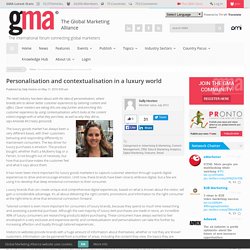
Clever retailers are taking this one step further and enriching this customer experience by using contextualisation, which looks at the content visitors engage with or what they purchase, as well as why they did so, says Amanda McCreary (pictured). The luxury goods market has always been a very different beast, with their customers behaving and responding differently to mainstream consumers. The key driver for luxury purchases is emotion. The product bought, whether that’s a Mulberry bag or a Ferrari, is not bought out of necessity, but how that purchase makes the customer feel and what it says about them. It has never been more important for luxury goods marketers to capture customer attention through superb digital experiences to drive and encourage emotion. Retaining loyalty Contextualisation plays an important part here. Meet The Designers. Forbes Welcome. FashRev Whitepaper Dec2015 screen.
Ch en consumer business made to order consumer review. Forbes Welcome. Haute Couture: What It Means, Who Buys It, And How Much It Costs. Giambattista Valli haute couture (Photos: Imaxtree) When Jennifer Lawrence walked the Golden Globes red carpet recently and was asked what she was wearing, she replied, “Christian Dior Haute Couture—I don’t know what it means, but I had to say it.”
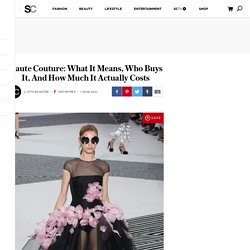
It was a rare candid red carpet moment for sure, but something tells us a lot of folks don’t actually know what the French phrase means. With the Fall 2015-2016 couture shows underway in Paris we decided to break down what haute couture actually is and what the fuss is all about. The History Haute couture—which literally means high sewing—can be traced back to the court of Louis XVI and Marie Antoinette’s reign, but it wasn’t formalized in France until English born designer Charles Worth burst onto the scene and opened his Paris atelier in 1858. It was Worth who founded the Chambre Syndicale de la Couture Parisienne to regulate the craft of haute couture. Haute couture continued during the war.
Elie Saab haute couture The Designers. Why do designers bother with haute couture? It's not easy for fashion houses to branch into haute couture.
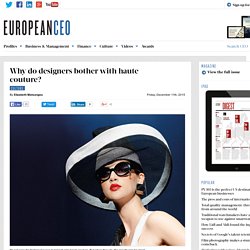
But when they do, the results can be great Although the roots of haute couture are deeply ingrained in France, the idea of high-concept, handmade, custom clothing was actually established by an Englishman from Lincolnshire. After moving to Paris, Charles Worth gained fame in the 1860s for the incredibly intricate and well-made dresses he produced for the wife of Napoleon III, Empress Eugenie. As demand among Parisian socialites burgeoned, Worth laid the foundations for the legends that soon followed in his footsteps, the most illustrious being the iconic Coco Chanel and Christian Dior. Comité Colbert. Le Comité Colbert, créé en 1954 à l’initiative de Jean-Jacques Guerlain, a choisi de porter le nom d’une figure marquante de l’histoire française.
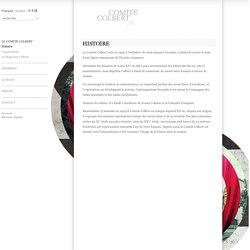
Intendant des finances de Louis XIV en 1661, puis surintendant des bâtiments du roi, arts et manufactures, Jean-Baptiste Colbert a fondé la renommée du savoir-faire français à travers le monde. Il a encouragé la création de manufactures, en important parfois des savoir-faire d’excellence, et l’exportation, en développant la marine, l’aménagement des ports et en créant la Compagnie des Indes orientales et des Indes occidentales. Homme de culture, il a fondé l’Académie de France à Rome et la Comédie-Française.
2016 Luxury Industry Predictions From The Experts. 2015 was a transformative year for the luxury industry across the globe, as new technologies, digital advances, currencies, wealth, media & marketing channels spurred a seismic power shift from brands to consumers, Baby Boomers to Millennials, traditional media to social, and West to East – to name a few.

But how these formidable trends will impact and evolve the industry in the year ahead has remained a mystery – until now. We spoke with a panel of our Knowledge Partners and industry experts to gauge their predictions for yet another dynamic year in the luxury industry to discover and divulge: How these trends will reshape 2016, what luxury brand executives should keep in mind when planning their future operations, and which regions, consumer segments and currencies are set to rule the luxury sphere next year. Ready-to-wear (pret-a-porter) Ready-to-wear (pret-a-porter) refers to ready made clothing which comes from the factory; the type of fashion is mostly applicable in clothing with some exceptions in items like bags.
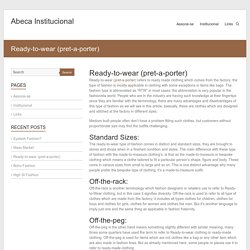
The fashion type is abbreviated as “RTW” in most cases; the abbreviation is very popular in the fashionista world. People who are in the industry are having such knowledge at their fingertips since they are familiar with the terminology, there are many advantages and disadvantages of this type of fashion as we will see in this article, basically, these are clothes which are designed and stitched at the factory in different sizes. Medium built people often don’t have a problem fitting such clothes, but customers without proportionate size may find the outfits challenging.
What is Ready-to-Wear Clothing? There is much to absorb in the fashion world, from understanding designers' styles and seasonal trends to the different terms used to describe types of clothes.

The term ready-to-wear is common among fashion circles, but most people do not truly understand what it means. Haute Couture VS Pret-a-Porter ( Ready-to-wear) I have often been asked the same questions —“What’s the difference between Haute Couture and Pret-a-Porter?”

When my friends read in the fashion magazine that certain movie star in the Red Carpet with description as “Angelina Jolie in Jean Paul Gaultier” or the other one “Angelina Jolie in John Galliano Couture”. They wondered, “What is the difference?” The difference is “Haute Couture” and “Pret-a-Porter” (or in English translated as “ready-to-wear” or as short form “RTW”) in the fashion industry. The first one means that Angelina Jolie wears ready-to-wear collection from Jean Paul Gaultier while the second one means that she wears the Couture collection from John Galliano. In today’s fashion designer’s world, a lot of popular and influential brands produce basically two categories of clothing.
The Trouble with Ready-to-Wear. LONDON, United Kingdom — For consumers, high-end fashion delivers significantly less ‘bang for buck’ than other luxury categories.
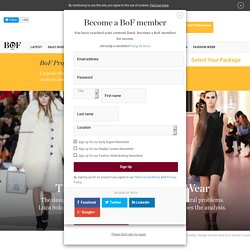
While you can wear the same watch or necklace or handbag every day — and always look good — you cannot wear the same dress to every event. Fashion is also a weaker signifier of status than other luxury items, as the brand of a piece of clothing is less immediately apparent than the brand of a bag, for example. Ready-to-wear - definition of ready-to-wear in English. Adjective (of clothes) made for the general market and sold through stores rather than made to order for an individual customer; off the rack.

Who Are Millennials. Believe that they have equal responsibility of child care Greater millennialbrand love Compared to 19% of non-millennials 46% of millennials post original photos or video online that they themselves have created Millennials value brands that enhance their lives. Hiut Denim.
Imagery. Transparency. Gabrielle "Coco" Chanel (1883–1971) and the House of Chanel. Fashion Revolution: The 2 Euro T-Shirt. For Fashion Revolution Day, we partnered with BBDO Berlin to create a quirky and memorable social campaign. We put our love for innovation to use and turned your average snack-dispensing vending machine into a social campaigning tool to raise awareness about the garment industry’s poor working conditions for children. Bright turquoise, it stood in the middle of Berlin’s Alexanderplatz and promised passersby a real bargain: one t-shirt for only 2€. After inserting the money and selecting their size, customers were surprised to see a video start playing on a 22” HD display fitted into the plexiglass.
They watched shocking scenes from textile factories of women and children sewing without a break, paid only 13 cents per hour for working under life-threatening conditions. Farmers, Producers and Factories. If you are a maker, a producer, a factory worker, a mill dyer or a cotton farmer, there are many ways you can get involved with Fashion Revolution throughout the year.
We invite the people who make our clothes to tell us their stories and connect with the people who wear them. This year we are introducing a new hashtag #imadeyourclothes, for producers, farmers, factories and makers to use in response to the question ‘Who made my clothes?’. We want to see the faces and hear the stories from thousands of makers, farmers and producers, and see an increasing number of brands make their supply chains more transparent. For more information download the pack below. Downloads Although our resources are free to download, we kindly ask for a £3 donation towards booklet downloads. I made your clothes poster (for producers) DownloadI made your accessories poster Download. Brands, wholesalers, retailers and distributors. Li Edelkoort publishes manifesto on why "fashion is obsolete" News: trend forecaster Li Edelkoort has published her Anti_Fashion manifesto, outlining why she believes the fashion industry "is going to implode".
The 10-point printed manifesto, published by Edelkoort's Paris-based agency Trend Union and subtitled "Ten reasons why the fashion system is obsolete", follows her declaration in an interview with Dezeen this weekend that we are witnessing "the end of fashion as we know it. " "These ten points argue that the industry has reached a vanishing point of fashion," she writes in the manifesto. "This means that the economy of clothes will take over from the turnover of fashion. " BBC iPlayer - Absolutely Fashion: Inside British Vogue - Episode 1 - Audio Described.
Emerging Trends. 'Storytelling of luxury products.'